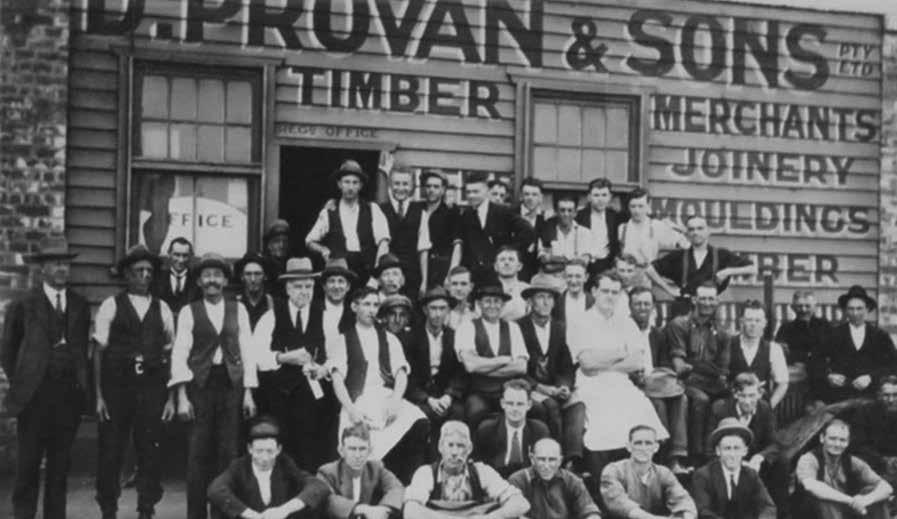
6 minute read
Implementing Risk Management into your business
NATIONAL
“We want to help people to pursue new careers,” Provan says.
“We’re encouraging mature-aged students, women, people who have decided to change from their current career to a timber trade and also people from marginalised, disenfranchised and financially disadvantaged groups to lodge an application for the 2021 scholarships. We think that funding their tuition, tools and materials may help them access these programs in a very tangible way.”
For further background on Provans Timber & Hardware visit www. provans.com.au
This scholarship certainly resonates with the MGA TMA Frederick O’ Connell annual scholarship which is currently open for applications. Visit www.mga. asn.au/frederick-richard-oconnellscholarship for more information.
MGA TMA late last year held a Risk Management Webinar on Safety Management Systems, with the assistance of MGA TMA Safety Consultant - Kevin Doherty, who revealed some not so obvious safety concerns that can be found in any business.
With over 30 year’s experience in the manufacturing industry, including the petrochemical industry, Mr Doherty also boasts 10 year’s experience consulting for a wide variety of businesses on safety and compliance.
Mr Doherty initially highlighted the aims of safety management, which included seeking to protect the health, safety and welfare of employees, while ensuring that the health and safety of the public is not put at risk by work activities.
Workplace and Occupational Health and Safety is a step-by-step process, according to Mr Doherty, who said there are four major steps involved.
“The four steps include identifying hazards, or finding out what could cause harm, assessing risks and understanding the nature of the harm that could be caused by the hazard and the likelihood of it happening, controlling risks with effective control measures and reviewing control measures.
Safety responsibilities
Any person who owns a business or enterprise (PCBU) has a primary duty of care to ensure the health and safety of any person who comes into contact with business activities including workers, contractors, visitors and members of the public, according to Mr Doherty.
“Health and safety legislation imposes specific duties on the officers of a business who can be found personally liable. Officers may be employees of a business but they also have a duty to ensure the WHS/ OHS legislative requirements are being met. Responsibilities apply to employers (PCBU), officers, managers, as well as employees,” he said.
Just as an example to MGA TMA members, Mr Doherty highlighted common risks that may be found in the timber industry including poor layout, lifting, repetitive tasks at the workshop, unloading, moving, installing finished products at client sites, machine/powered-tool guarding exposure to wood dust and noise, forklifts, trucks and other vehicles, as well as injury management and return to work
Duties of employers
Under the legislation, an employer or person conducting a business or undertaking (PCBU) has a duty to ensure health and safety, according to Mr Doherty.
NATIONAL
“This duty includes elimination of risks to health and safety, so far as is reasonably practicable, as well as monitoring workers’ health when they are conducting hazardous activities. This duty includes notifying the relevant safety regulator of certain accidents and incidents in the workplace, as well as consulting with workers on health and safety issues. In some circumstances this could also mean appointing a health and safety representative (HSR) and a health and safety committee, as well as keeping appropriate health and safety records, while co-operating with inspectors from the health and safety regulator,” he said.
“To comply with your duty, you must provide and maintain safe systems of work, including a safety management system to ensure people at the worksite are not exposed to risks. You must also provide and maintain safe plant and equipment, as well as ensuring the safe use, handling, storage and transport of plant or substances. Each workplace must be maintained in a safe manner so that the physical premises does not pose risks to health or safety,” Mr Doherty said.
“Employees must also provide adequate facilities for the welfare of workers, including break areas, staff kitchen and toilets, as well as consult with workers and provide them with adequate information, training, instruction and supervision. Failure to comply will constitute a breach of the health and safety legislation.”
Ensuring health and safety
When it comes to knowing what is reasonably practicable in relation to ensuring health and safety in a workplace, this means taking into account and weighing up all relevant matters, Mr Doherty said.
“These matters include the likelihood of the hazard or the risk concerned occurring, the degree of harm that might result from the hazard or the risk, what the person concerned knows, or ought reasonably to know about the hazard or the risk, and ways of eliminating or minimising the risk.”
“After assessing the extent of the risk and the available ways of eliminating or minimising the risk, matters also include the cost associated with available ways of eliminating or minimising the risk, including whether the cost is grossly disproportionate to the risk,” he said.
Duties of workers and employees
Firstly, a worker or employee is someone who carries out work for a person conducting a business and this can include employees, contractors or sub-contractors, employees of contractors or sub-contractors, labour hire personnel, truck drivers, volunteers, trainees, apprentices, work experience persons or those that work from home, according to Mr Doherty.
“In saying this, all workers or employees must take reasonable care for their own safety; ensure that their acts or omissions do not endanger others; cooperate with policies and procedures as laid out by the business; comply with lawful instructions given by the employer, while also not engaging in discriminatory conduct. Serious breaches of the legislation by employees carry significant penalties.”
“It is also your legal duty to provide and maintain a safe place of work. By conducting a risk assessment, you will be able to identify the high-risk activities in your business and be able to prioritise those areas which need attention in a planned and organised manner,” he said.
There are three stages to risk assessment including assessing the inherent risk, considering the current controls already in place, and also assessing your residual risk. “Inherent risk is an assessment of risk if there were no controls of any sort in place. The reason for this is that it was found that people tended to under evaluate the potential for harm. Residual risk is different because it is an assessment of risk after controls have been placed to mitigate the risk. Then risk is the reassessed to ensure the risk has been reduced sufficiently or requires further controls,” he said.
Risk assessment template
Mr Doherty also provided a Risk Assessment Template business owners may use to record risk details throughout their businesses.
The process for completing the risk assessment template is straightforward and consists of three stages.
Stage one consists of: 1. Identify and record each individual hazard. 2. Determine the impact which this hazard would cause. 3. Assess the risk assuming there are no safeguards in place using the risk calculator. 4. Determine the likelihood that an incident might occur. 5. Determine the consequence if an incident did occur. 6. Multiply the likelihood by the consequence to give the Inherent
Risk Rating. Stage two consists of: • Considering the controls which are currently in place. • Listing all the controls relative to the hazard in the Current Controls column. This might include safety guards, training provided to operators or the issue of Personal protective equipment (PPE), to name a few. • Business owners can only list the controls which have been implemented and they are certain the proper procedures are being followed.










